
|
Today's Calendar |
| | Simply Economics |
| | International Perspective |
| | Resource Center |
 |
|
| 1999 Articles |
|
International Perspectives - November 1, 1999
A positive week
European Central Bank is poised to act... 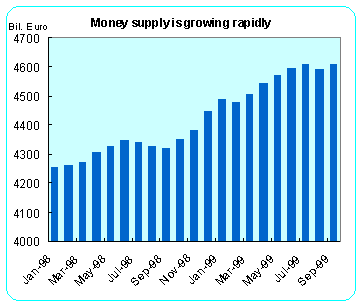 The ECB uses two major indicators when making policy. The first is the harmonized consumer price index for the European Monetary Union as a gauge of inflation. The CPI remains safely under their target rate of about two percent inflation for the EMU as a whole, although there are some member countries that are either dangerously close to the target or even above the accepted rate. With September's M3 registering a 6.1 percent annual growth rate, following hard on the heels of August's 5.9 percent jump, analysts think that the European Central Bank will use these data to justify an interest rate increase at Thursday's meeting. The Bank's M3 reference growth rate is about 4.5 percent on an annual basis. A month ago, ECB officials drew attention to M3 by warning that money supply growth and credit expansion required close scrutiny. ECB president Wim Duisenberg said at that time that the governing council is ready to raise rates once it sees signs of an improving economy. However, officials have cautioned that it would not make a rate change solely on one indicator. With the ECB still trying to establish its credibility, some think that their primary policy rate, which now stands at 2.5 percent, will be raised by either 25 or 50 basis points on Thursday.
Across the channel...
Indicator scoreboard
Europe The global deficit also narrowed in August. But this reflected a reduction in the surplus on trade in oil and in the deficit on trade in erratic items. The trend in the whole world goods deficit continues to be flat with both imports and exports climbing. The trend in the whole world goods and services deficit, on the other hand, is narrowing.
Germany September import prices increased one percent, primarily because of higher oil prices. Excluding oil prices, import prices were up 0.5 percent. The annual import inflation rate was positive in August for the first time since February 1998 and surged in September to 2.7 percent. Excluding oil, import prices were down 0.4 percent on the year. Export prices rose 0.4 percent on the month and 0.2 percent on the year. West Germany's September business sentiment in the manufacturing sector continued to climb into positive territory. The current conditions and business expectations subindexes also increased. Ifo also said that manufacturers and west German wholesalers expected their prices continued to rise in September. West German seasonally adjusted retail sentiment plunged, offsetting the increases in manufacturing and wholesale confidence. The previously reported overall seasonally adjusted Ifo west German business confidence index was unchanged at 95.4 in October. Third quarter industrial production began at a weaker pace than originally thought. July output was revised down sharply by the Bundesbank. However, industrial production earlier in the year was revised up. Industrial activity in the second quarter was much stronger than previously expected. The net effect is that some of the output strength seen in July was transferred back into the second quarter. August industrial productivity per employee and per hour worked in the manufacturing and mining industries increased on a monthly basis. Unit wages costs declined 2.2 percent in August on a monthly basis after rising 1.3 percent in July. Seasonally adjusted productivity per employee in August rose 1.1 percent from July and stood 1.5 percent above the year-earlier level.
France September's seasonally adjusted number unemployed dropped to 11.1 percent from 11.3 percent in August. France uses the International Labor Organization definition of unemployment and excludes job seekers that did any work during the month. When compared with September 1998 when the ILO rate stood at 11.8 percent, unemployment was down 169,000 or 5.5 percent. The drop in unemployment was sharper than expected. 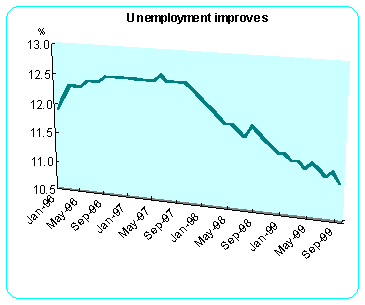
Italy August unadjusted retail sales fell one percent when compared with last year. This is the lowest reading since January 1997. In July, retail sales rose 1.3 percent when compared with last year after falling back from June's 2.3 percent gain. September non-EU trade deficit was below market expectations as the continued rise in imports more than offset the improvement in exports. September is often a volatile month for trade figures, and follows a strong August surplus. In August, the surplus with its EU trading partners continued to climb. European Union exports increased 10.2 percent while imports jumped 7.4 percent over August 1998. September hourly wages continued to rise steadily with contract renewals for retail workers the main factor behind the increase. The September year-on-year rise was above analysts' expectations and was the highest since December 1998, when the index rose 2.2 percent when compared with the previous year. October's inflation rate was up 0.4 percent registering the sharpest jump since November 1997. The annual inflation rate came in at two percent, the highest level registered since September 1998. Rising gas and energy prices pushed up transport costs by 0.5 percent on the month and by 3.9 percent on the year. Italy's annual inflation rate is well above the European Union average of 1.2 percent. Only Ireland with 2.6 percent, Spain with 2.5 percent and Denmark with 2.4 percent registered higher rates.
Spain
EMU 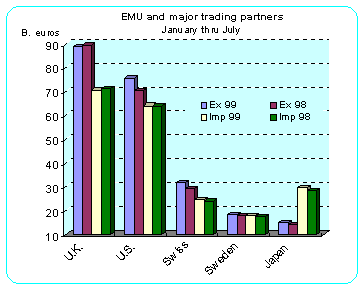 August's trade surplus with the rest of the world for the European Monetary Union was 3.7 billion euros during August, down from a surplus 6.1 billion euros a year earlier. In July, the trade surplus stood at 12.0 billion euros, revised down slightly from the 12.1 billion euros surplus initially reported. Euroland exports continued to grow more slowly than imports when compared with last year. However, trade within the EMU rose eight percent when compared to last year. August EMU-11 exports were up three percent from August 1998, the same as reported in July. Imports were up eight percent when compared with last year and up from 6 percent in July. August industrial production surged more than expected when compared to a year earlier. The data suggest that the economy is growing faster than many expected. Increases were particularly strong in Italy (7.3 percent) and Spain (4.3 percent). The jump was led by the durable consumer goods sector, where output rose 11.8 percent. Durable consumer goods output was particularly strong in Italy and Germany, the laggards in the Euroland economy. In addition, August year over year output climbed 3.1 percent in nondurable consumer goods, 2.6 percent in intermediate goods and 0.3 percent in capital goods.
Asia September retail sales fell two percent when compared with the previous year while overall sales including wholesale sales fell 5.9 percent on the year. Wholesale sales dropped 6.8 percent on the year while sales at large scale retail stores dropped 1.7 percent or 3.1 percent when adjusted for new stores and stores closing. Retail sales fell 1.6 percent in August and 2.4 percent in July. September's seasonally adjusted industrial output dropped 0.8 percent when compared with August but was up by an unadjusted 2.6 percent on a year earlier. Industries that contributed to the decline were general machinery, electrical machinery and plastic products. Commodities that contributed to the decrease were printing machines, personal computers and parts of steam turbines. The jobless rate edged lower in September to 4.6 percent from 4.7 percent in August, registering the second straight month of declines. The last time the jobless rate fell for two straight months was in February and March 1996. The drop in the jobless rate partly reflected the growing desperation of Japan's unemployed ranks, as more jobless people took on temporary jobs. The number of part-time or temporary workers rose from levels a year earlier by 210,000, or 4.3 percent, to 5.12 million. The number of such workers has increased in every month since September 1996. But the total number of jobholders fell by 120,000 from levels a year earlier, marking the 20th straight month in which the number of jobholders fell.
Australia Americas 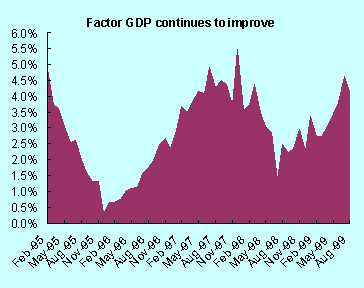 September industrial product prices were up 0.5 percent. When compared with a year earlier, industrial product prices were up 3.1 percent. Intermediate goods prices were up 0.7 percent on the month and increased 3.6 percent on the year, while finished goods prices were up 0.1 percent from a month ago and 2.1 percent against a year ago. Petroleum and coal products increased five percent on the month, pulp and paper products were up 1.8 percent, and chemicals and chemical products were up 1.6 percent. The largest declines were for lumber, sawmill and other wood products (-1.7 percent) and meat, fish and dairy products (-1.4 percent). The raw materials price index soared 3.5 percent because of an 11.5 percent surge mineral fuel prices. Excluding mineral fuels, the raw materials index was down 0.6 percent and up 1.6 percent when compared to a year ago. Only two of the index's seven major components increased while four declined and one remained unchanged.
World equity markets
Japan
Europe  France's CAC index closed the week at a new high. It gained 4.5 percent on the week on favorable economic news, especially on the unemployment front. Germany's DAX also was exuberant, closing up 3.13 percent on the week. The news from the United States had as much to do with the soaring equities markets as did domestic economic news. The EMU countries however, are fretting over a possible interest rate increase by the European Central Bank at its meeting on Thursday. Currencies 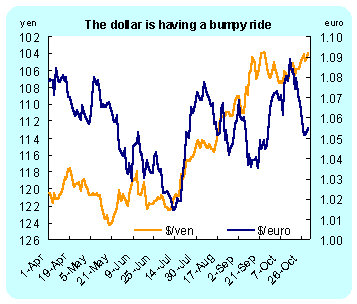
Euro
Why U.S. investors care...
Release dates are subject to change. |
|||||||||||||||||||||||||||||||||||||||||||||||||||||||||||||||||||||||||||||||||||||||||||||||||||||||||||||||||||||||||||||||||||||||||||||||||||||||||||||||